Source: The Conversation (Au and NZ) – By Jonathan W. Marshall, Associate Professor & Postgraduate Research Coordinator, Western Australian Academy of Performing Arts, Edith Cowan University
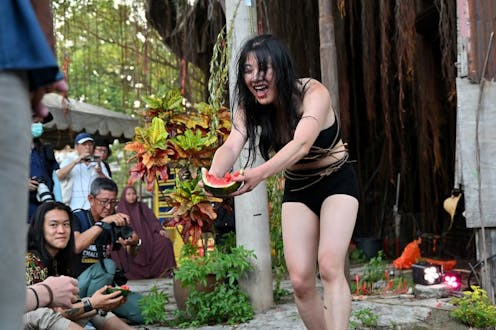
Photo by and courtesy of Teo Swee An.
Melbourne-based Tony Yap is a leading figure in Australian interpretations of the abstract Japanese dance form of butoh and what he calls “trance dance”. In butoh and trance, movers consider the body as a porous receptacle for spirits and forces from outside of it, and which comes to move it.
Yap founded the Melaka Art & Performance Festival (MAPfest), staged in the Malaysian city of Melaka, in 2008, and this year’s festival ran from August 26 to September 1. Departing from butoh itself, many of the performances involved different levels of introspection and trance, where the focus and concentration of the performers was so intense that they barely seemed aware of their surroundings.
There were also works of what one might call “postmodern classicism”, which draw on ritual and traditional dances from Indonesia and surrounds, reworked within an abstract contemporary framing.
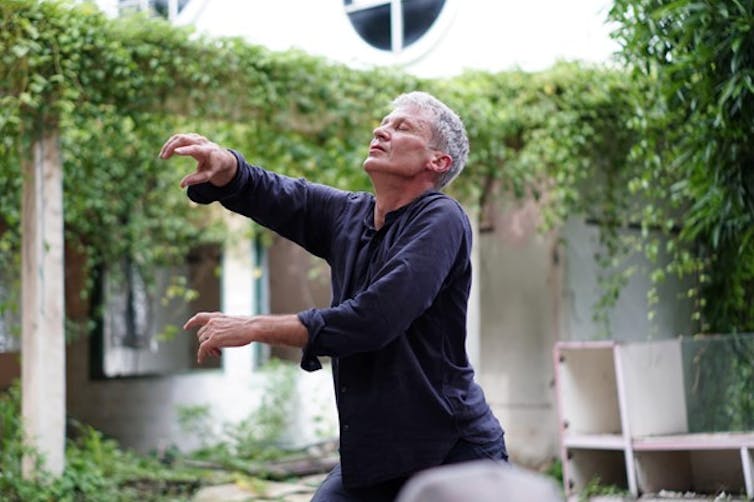
Photo by and courtesy of Cheah Shelley.
MAPfest features work from experienced masters like Yap, and developing artists – among the more than 50 participants, the youngest artist in this year’s program was just 13 years old. There is a non-hierarchical approach to programming, and pieces are staged for the other performers as a residency designed to showcase work at five locations across Melaka.
Cultural exchange
Traders have moved between Melaka and China since the 15th century, and Yap’s Chinese ancestors have been in Melaka for over three generations.
Melaka has a long history as a site of trade and cultural exchange. The Islamic Sultanate was colonised by Portugal in 1511. Portuguese rule was followed by Holland, Britain and Japan. In 1963, the state of Malaysia was founded. Today, the city is home to ethnic Malays and Chinese, Indian and Eurasian communities.
The city’s relationship to MAPfest hasn’t always been smooth. At one festival, Yap tells me, a dancer embraced the statue of St Francis Xavier situated beside the Portuguese Church of Saint Paul. This led to restrictions on access.
Today, MAPfest’s participants deploy an almost guerilla approach to staging. I have not been involved in a production which seemed so risky, so negotiated in the moment right now, since my student days.
The locations of advertised performances shifted hourly; performers danced under garlands dripping flames; outdoor venues often had dubious surfaces to dance on, presenting hidden dangers. Following updates posted on Messenger, I scuttled from venue to venue, and up winding, nearly condemned staircases, held in place by improvised chains.
Just finding the performance could be an adventure.
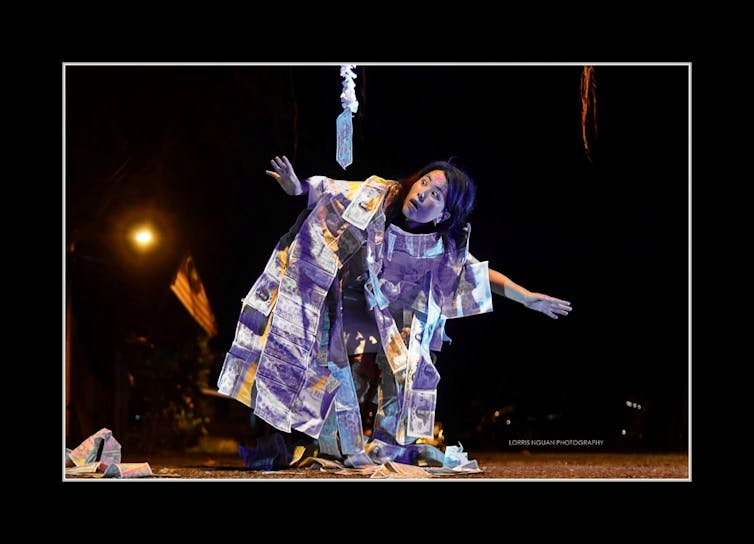
Photo by and courtesy of Lorris Nguan.
Beyond the pretty UNESCO-protected homes of old Melaka lie decaying, overgrown areas, dotted with ruinous 20th century structures. These buildings, open to the elements from above and to the sides, rest amid fields of weeds (which performer Leslie Azzis burrowed beneath), and a temple soon to be bulldozed (home to Kiki Ando’s constantly evolving critique of consumerism).
Some of the most open-ended, improvised pieces were performed here, such as Adam Forbes’ mesmerising portrayal of an almost fluid body. Moving from behind a hanging piece of damaged roofing, he curled and slid across a vine-tangled white wall, dropping to his knees, shoulders rising and falling unevenly, before slowly crossing a plank to approach the audience.
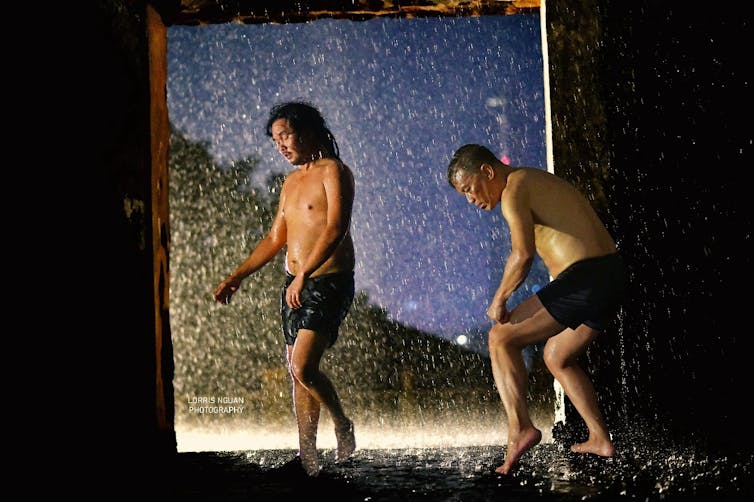
Photo by and courtesy of Lorris Nguan.
Even more unexpected was when the multiracial party of artists gathered on a platform below the 16th century Church of Saint Paul to conduct one of three “animalising trance” workshops.
A tropical downpour forced us to seek cover in the remains of the ruined church up the hill. Hardier members moved onto the drenched, uneven stone pavings. Soft splashings in the puddles added an atmosphere of wonder.
As Yap told me later, this was typical of Melaka, where a problem leads to something unplanned and magical.
Destruction of the ego
The closing performance, the large scale, ecstatic improvisation Eulogy For the Living, was presided over by Javan trance master Agus Riyanto. Riyanto set up an altar at the rear of an indoor skate park, adorned with incense and offerings. He paced around the dancers, cracking a whip to bring on, and then dispel, trance.
Yap likened Eulogy For the Living to the involuntary, therapeutic dance of southern Italy known as tarantism, to the convulsive, almost hypnotised postures 19th century physicians witnessed in their hysterical patients, and to Antonin Artaud’s 1931 essay comparing theatre to the plague.
Artaud wrote that both theatre and the plague take “images [of] latent […] disorder and suddenly carries them to the point of the most extreme gestures” so there is a “destruction” of the ego.
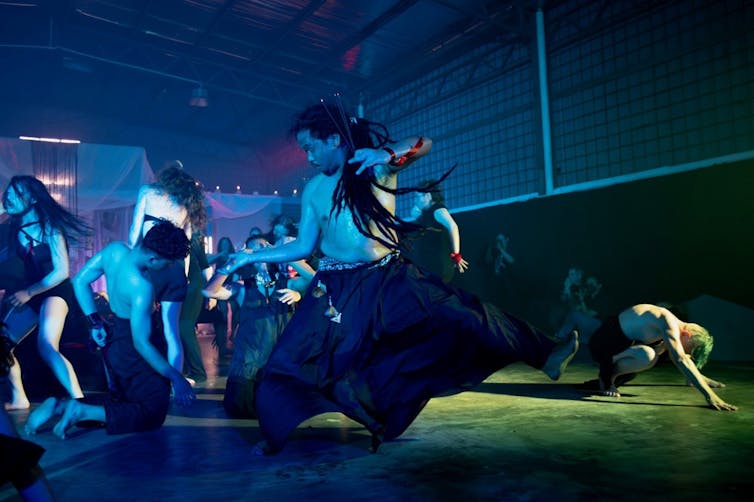
Photo by and courtesy of Teo Swee An.
Yap instructed male participants to wear black dresses, further evoking the mad rituals performed by acolytes of theatre’s sex-changing patron, Dionysus.
The choreography was by turns bouncy and vibrating (tarantism), extreme and violent (hysterical or plague-like), collective and infectious, as well as blending lyricism with mourning and gender ambiguity (Dionysian).
The performance cycled through eight or so states, plateauing before energy rose again. An otherworldly din of drone and electronic noise music sustained these choreographic cycles.
Resolving the performance, Riyanto flicked water from garlands onto the dancers. Many trancers required further ministrations from him to expel resistant visiting forces.
I was seated to one side in Muslim robes I had purchased nearby. Smoke from the incense burned my eyes, almost forcing me to exit, as the dancers groaned and meditated before me. Eulogy For the Living provided an epic, immersive conclusion to a week of performance.
If a city characterised by cross-racial couplings and sometimes fraught multicultural exchanges can be translated into a festival, then this year’s MAPfest ably rose to the challenge.
![]()
Jonathan W. Marshall does not work for, consult, own shares in or receive funding from any company or organisation that would benefit from this article, and has disclosed no relevant affiliations beyond their academic appointment.
– ref. At Melaka Art & Performance Festival I watched dancers overcome by a trance in the rain, and the smoke – https://theconversation.com/at-melaka-art-and-performance-festival-i-watched-dancers-overcome-by-a-trance-in-the-rain-and-the-smoke-238551








